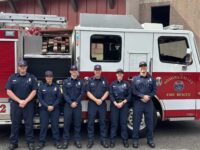Highway 12’s tagger community will soon face some stiff-brushed competition, following a recent action by the Springs Redevelopment Advisory Committee.
The RAC voted unanimously Thursday night to have the county fund up to $3,000 for the Valley of the Moon Teen Center’s budding graffiti abatement program, redevelopment manager Boris Sztorch said Tuesday.
“We’re shooting for July 8 to take it to the Board of Supervisors,” Sztorch said,
The Teen Center operates the program as part of a gang-intervention effort with the Sonoma County Sheriff’s Department and the Boys & Girls Clubs of Sonoma Valley. Youths enter the graffiti program as part of a community service requirement – either as criminal offenders, or as leadership students with the Boys and Girls Clubs’ Keystone Club.
Sztorch said the money will go for paint, masks, gloves and other cleanup equipment. On the list of cleanup sites are the Highway 12 corridor, local schools and playgrounds – in particular, Larson Park. He said that once the program gets moving, turnaround time from scrawl to sponge is expected to be 24 to 48 business hours.
The RAC also discussed, but took no formal action on, two other improvement-funding issues last Thursday – namely, pavement and drainage for Mulberry Avenue, and a possible $10 million shortfall for the long-awaited Highway 12 upgrade.
“We’ve got close to six million on hand,” Sztorch said of the latter, adding that the “most probable” financing solution for the latter would be for the Board of Supervisors to issue a bond. He said the Board was still looking into the idea, adding that bids are scheduled to be awarded by mid-October for the $4 million Encinas Lane–Boyes Boulevard project. The second phase, from Boyes Boulevard to Agua Caliente Road, is expected to be completed by 2011.
Sztorch said $500,000 would be a “very preliminary number” for improving Mulberry Avenue. Residents would like to partner with the county in a “pilot project” that could be used as a fundraising model in other communities, and Sztorch said one discussed possibility would be for the residents to create a “benefit assessment district.” whereby they could pay back redevelopment loans.
“By partnering our funds with their funds, we can do a lot more projects,” he said.
Graffiti program
More from What's HappeningMore posts in What's Happening »




